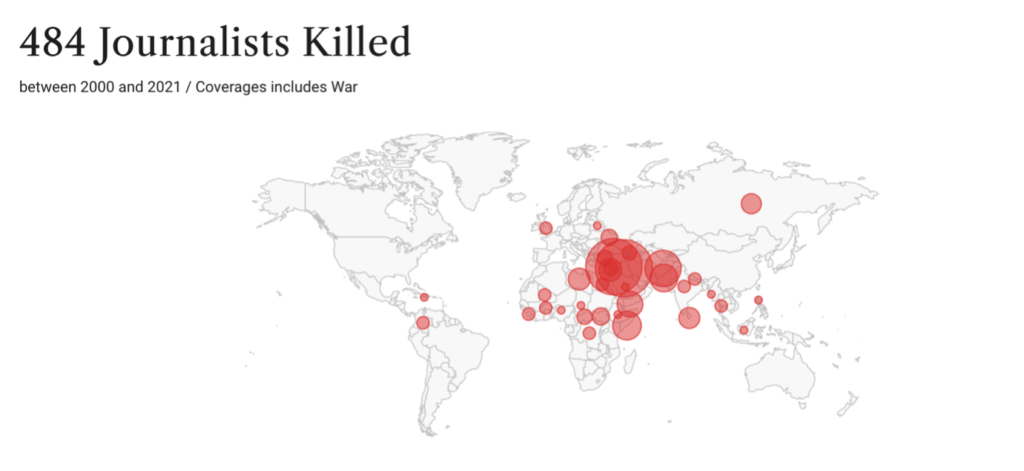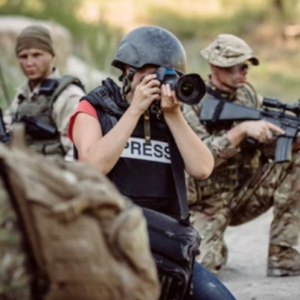Regardless of their essential role and responsibility, it is a recurring fact that journalists may disappear, may be threatened, may be arrested, may be mistreated and/or killed during conflicts. It is not only the loss of lives as collateral damage during military operations that make journalists’ jobs in conflicts so dangerous, but also targeted attacks, as well as the constant danger of being kidnapped, arrested, or accused of espionage.
The international organization “Committee to Protect Journalists” presents sad statistics (see image (1)) about journalists who practice journalism in war zones- a dangerous occupation that requires being in the centre of events connected with deaths, violence, risk to their own lives. UNESCO reported that during 2018-2019, 42% of journalists killed were in a conflict zone (2).

Thus, journalists should always bear in mind the question; What is more important – your life or your report? If you can tell the story without taking the risk, or in a different way, it might be better?
In Pakistan, years of oppression and censorship harden Pakistani journalists’ ability to do their job. Caught between the pressures of reporting independently on security forces and their role in the conflict, the religious right-wing and extremist groups such as al Qaeda and the Pakistani Taliban – journalists learned to self-censor and walk an invisible tightrope to survive (3).
Planning
Military forces cannot always protect journalists’ safety on the ground, and media professionals may be left alone in extremely difficult situations. Journalists should be acquainted with some guidelines and skills before reporting in grey zones, in which state and non-state actors engage in competition, and where it is not clear whether something is legal or not. Thus, competencies such as the ability to adequately respond to the situation and self-reliance in critical situations are especially relevant.
Before going to a High-Risk Zone* (HRZ), planning is an essential element of the journalist’s work because this is probably the only way to manage risks. Furthermore, for every situation, one should also have a contingency plan (or plan “B”) because in the conflict zone, the situation may change at any time. All precautions should be revised daily.
Reporting in conflict zones requires experience and precaution. Knowledge about each war zone is necessary as each conflict has its unique context and risks. Some information to gather before a mission
- Climate and fauna specifics
- Specifics of combat operations conducted by the conflicting parties
- Types of machinery they use
- Diseases and medication
- Religious and cultural differences
- Defining and ranking risks
Guidelines
Traveling through a war zone alone is always very difficult. The better one knows a country, the easier it becomes, as a journalist may have enough contacts to work independently in at least some parts of a war zone. But even then, media professionals should always follow some steps in order to maximise their security.
Careful planning to prevent security incidence encompasses several themes.
- First, more generally, there are basics guidelines such as checking your vehicle and putting together a survival kit (warm clothes, a helmet, a duvet, first aid kit, water and food), assemble official documents, such as press cards and any relevant laissez-passer, not carying anything that could confuse people about your role as an observer, such as binoculars, signalling devices, military-style clothing or weapons. Identify yourself as media. You can paint MEDIA or PRESS in large letters on the side and top of the vehicle/clothes. Nevertheless, check if it is a deterrent because in some contexts, this will make you a target.
- Second, more practically, study the route map and stick to the planned route. Stay in regular touch with the news desk or with other journalists. Don’t drive at night. Moreover, wear appropriate dark clothing since discretion is key. This also means that you should switch off your telephone and any cameras, radios, and recorders. If faced with searchlights, lie flat on the ground and wait for them to go off. Furthermore, checkpoints are roadblocks manned by guards, who may be regular troops or irregular forces such as bandits, rebels or militia. They may try to extort money or equipment, or even seize the car and capture its occupants. Hence, checkpoints are an important danger to consider. When you approach an unidentified checkpoint, contact your news desk and give them your location or a convenient small electronic device that alerts rescue authorities in their search to locate people in distress. Furthermore, always keep the doors locked and lower the window on the driver’s side slightly, just enough to talk to the guards. Remove your sunglasses, keep your hands visible at all times and avoid sudden gestures.
- Lastly, in the event of heavy artillery fire and aerial bombardment, you need to protect yourself from the blast and also from the resulting shrapnel and fragments: don’t panic, and instead of trying to run away, lie flat on the ground and crawl to the nearest safe place in order to protect yourself from the impact. For example in a hole in the ground or the centre of a building, in the stairwell and away from windows (to protect yourself from shattering glass). Do not use cellars or attics, which are prone to collapse. Make sure you have several exits to the outside. Remain flat on the ground and cover your head.
For more guidance in high-risk environments; A Survival Guide and the Safety Guide for Journalists. Broader information can be found in the Safety of Journalists Resource Guide and FPU Safety Policy
Working with the military

Working with the military can offer access to the front line. Sometimes, it is the only chance to get to areas where you want to work. However, if you travel with the military, you risk becoming a target, either because you are mistaken for a soldier or because you are considered to be associated with the enemy. If you decide not to be escorted by the military, then travel with someone who is experienced in the area and only when you are confident that you will not become a target. But no matter what, always listen to your superior and/or guide.
Footnotes
- CPJ Database of attacks on the press. Committee to Protect Journalists
- Director-General’s report on the safety of journalists and the danger of impunity. (2020). UNESCO
- Abid Zehra. (2021). One of the most dangerous places in the world: Journalists in Pakistan are caught up among military, mullahs and militants.
*Conflict Affected and High-Risk Areas (CAHRAs): According to the OECD conflict-affected and high-risk areas (CAHRAs) are characterised by “the presence of armed conflict, widespread violence or other risks of harm to people.”
